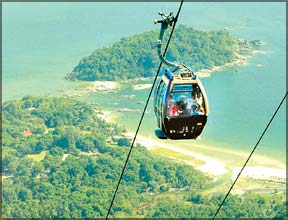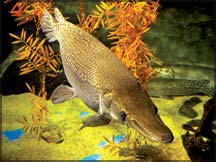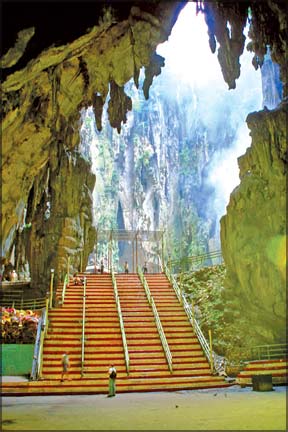|
Malaysia:
Langkawi-shrouded with myths and legends
Malaysia at a glance
The Federation of Malaysia comprises Peninsular Malaysia, which is
made up of 11 States, three Federal Territories as well as the States of
Sabah and Sarawak situated in Borneo.
|

Cable car |
Capital city: The capital city of Malaysia is Kuala Lumpur.
Geographical location: Located between two and seven degrees north of
the Equator, Peninsular Malaysia is separated from the States of Sabha
and Sarawak by the South China Sea. To the north of Peninsular Malaysia
is Thailand while its southern neighbour is Singapore. Sabah and Sarawak
share a common border with Indonesia while Sarawak also shares a border
with Brunei Darussalam. Area: 329,758 km2 Population: 27 million People:
Malays make up about 50 percent of the population and are the
predominant group with Chinese, Indians and other ethnic groups making
up the rest.
Language: Bahasa Malaysia (Malay) is the national language but
English is widely spoken. Malaysians also speak various languages and
dialects.
|

Underwater world |
Religion: Islam is the official religion but all other religions are
practised freely.
Government: Malaysia practices parliamentary democracy and
constitutional monarchy. The Head of State is the Yang di-Pertuan Agong
and the Head of Government is the Prime Minister. The country has a
bicameral legislative system.
Climate: Malaysia has a tropical climate and the weather is warm all
year round. Temperatures range from 21 C to 32 C and the annual rainfall
varies from 2,000 mm to 2,500 mm.
Malaysia for some would be a country steeped in history with much
historical facts on offer and for others somewhat like a Mideastern
country with a Muslim culture with people speaking a different dialect.
But it certainly turned out to be a country that has something to offer
everybody.
|

Batu caves. Pictures: www.google.com |
Malaysia boasts of a skyline that reflect much of the tangible
make-up of the country - combining with pre-war and colonial structures
some of which are Sultan Abdul Samad Building, the Central Market and
the old Kuala Lumpur Railway Station and of course the modern stand out
buildings spattered around. In particular the Petronas Twin Towers take
top billing as it is the tallest twin towers in the world with a height
of 1483 feet. Much of the high risers are found in the capital of Kuala
Lumpur (KL) - the Garden City of Lights.
On a recent familiarisation tour organised jointly by Thai Airways
International and Tourism Malaysia for a group of travel agents and two
journalists, it was quite a learning experience of how multiple
religions coexisted peacefully in Malaysia, a predominantly Muslim
country. The tour was initiated by Thai Airways General Manager Weerawat
Swasdibutra to promote bilateral tourism in Thailand and Malaysia.
The main gateway to Malaysia is through the new Kuala Lumpur
International Airport (KLIA) at Sepang, located approximately 55 km
south of Kuala Lumpur.
Several public transport options provide easy access to the city.
There are also other airports - at Penang, Johor Bahru, Kuching, Kota
Kinabahu and the island of Langkawi. An excellent road and railway
network links KL to Thailand in the north and Singapore in the south.
Once any visitor steps into Malaysia there is a well developed and
efficient public transportation system and service (buses, taxis as well
as trains are aplenty) available. It won’t harm if you try to haggle a
taxi fare with a driver but generally you are unlikely to be ‘taken for
a ride’.
There is an express train service - KLIA Express - that costs
approximately Malaysian ringgits (RM) 35 that leaves the airport to the
KL Sentral Station plying non-stop a distance of 50 km in 28 minutes.
(You can safely enjoy a cuppa and won’t feel shaken or stirred!) The
train departs every 15 minutes or 20 minutes depending on the peak
times.
This is one of the fastest modes of transport that connect the
airport to the KL Central Station.
Langkawi
One of the most alluring places of Malaysia is Langkawi (The Jewel of
Kedah) which is accessible by road, rail, air or by sea. Those
travelling by road have to drive to Kuala Kedah on the north-western
coast of Peninsular Malaysia.
The route from KL to Kuala Kedah takes approx 6 hours while Kuala
Perlis is an additional hour away. There are also direct air services
from KL to Langkawi. Rail services too are an option to visit Langkawi.
These services operate from KL to Alor star. From there a taxi or bus
could be taken to Kuala Kedah from where one could proceed to Langkawi.
Regular services are also provided by Express ferries to Langkawi
from Kuala Kedah. The journey from Kuala Kedah to Langkawi takes just
over an hour while it takes 2 1/2 hours from Penang to Langkawi.
Pregnant Maiden
The Lake of the Pregnant Maiden a.k.a. Tasik Dayang Bunting is
something that would capture anyone’s attention purely for its name.
The name of this lake in Langkawi is attributed to the legend of a
lovely fairy princess who married an earthly prince.
Her first child had died after birth. It is said that she was so
depressed that she buried the child in the crystal clear waters of the
lake.
And before returning to her celestial abode she blessed the water so
that any childless maiden who bathed in the lake would conceive
thereafter.
To reach the lake one has to first get to the Island of the Pregnant
Maiden and then take a short walk through the forest reserve. There are
three geo-forest parks in Langkawi. At the Kilim Karst beautifully
formed landscapes of nearly vertical to sub-rounded karstic hills and
pinnacles of various shapes and sizes could be seen.
Cable car
The Langkawi Cable Car with a length of 919 metres has been named the
‘longest free span single rope cable car’ by the Malaysian Book of
Records.
It is claimed to have one of the steepest gradients in the world, at
42o.
There is also a sensation-giving 125m suspension bridge. This is said
to be a remarkable feat of engineering with a curved bridge that links
the cable car station to the Machincang mountain range.
Langkawi cable car is at the Burau Bay, about 30 minutes away from
Kuah town.
Underwater world
The island’s rich treasure trove of marine life could be seen at the
Underwater world at Langkawi. Located at the Cenang beach this aquarium
features over 5000 types of aquatic life.
There is also a giant tank that displays large marine species such as
sharks, stingrays, eels and green turtles, with a 15 metre tunnel for
visitors to walk through.
-Ruwan |



